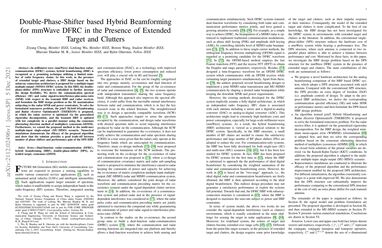Double-Phase-Shifter based Hybrid Beamforming for mmWave DFRC in the Presence of Extended Target and Clutters
In millimeter-wave (mmWave) dual-function radar-communication (DFRC) systems, hybrid beamforming (HBF) is recognized as a promising technique utilizing a limited number of radio frequency chains. In this work, in the presence of extended target and clutters, a HBF design based on the subarray connection architecture is proposed for a multiple-input multiple-output (MIMO) DFRC system. In this HBF, the double-phase-shifter (DPS) structure is embedded to further increase the design flexibility. We derive the communication spectral efficiency (SE) and radar signal-to-interference-plus-noise-ratio (SINR) with respect to the transmit HBF and radar receiver, and formulate the HBF design problem as the SE maximization subjecting to the radar SINR and power constraints. To solve the formulated nonconvex problem, the joinT Hybrid bRamforming and Radar rEceiver OptimizatioN (THEREON) is proposed, in which the radar receiver is optimized via the generalized eigenvalue decomposition, and the transmit HBF is updated with low complexity in a parallel manner using the consensus alternating direction method of multipliers (consensus-ADMM). Furthermore, we extend the proposed method to the multi-user multiple-input single-output (MU-MISO) scenario. Numerical simulations demonstrate the efficacy of the proposed algorithm and show that the solution provides a good trade-off between number of phase shifters and performance gain of the DPS HBF.
PDF Abstract